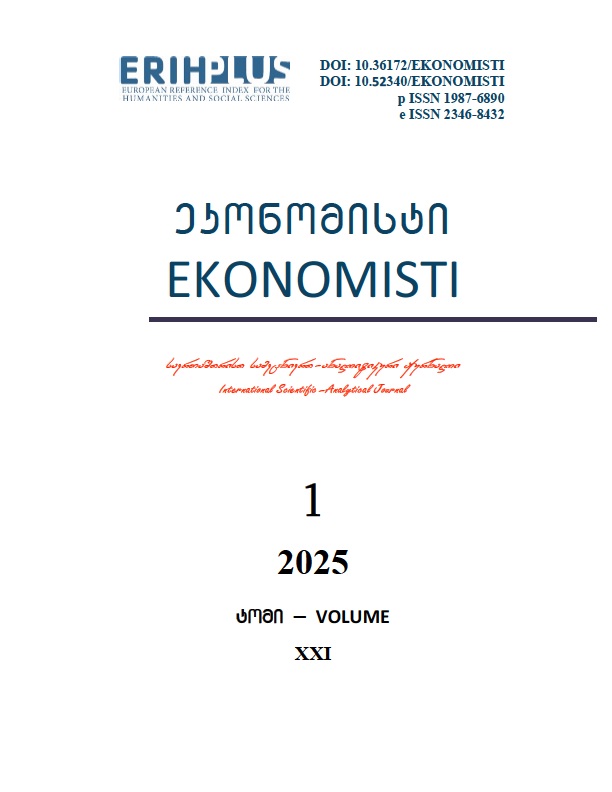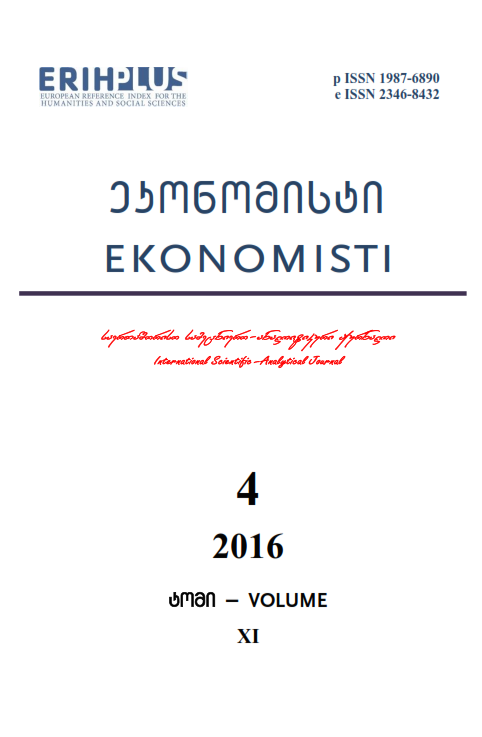
The international scientific and analytical, reviewed, printing and electronic journal of Paata Gugushvili Institute of Economics of Ivane Javakhishvili Tbilisi State University
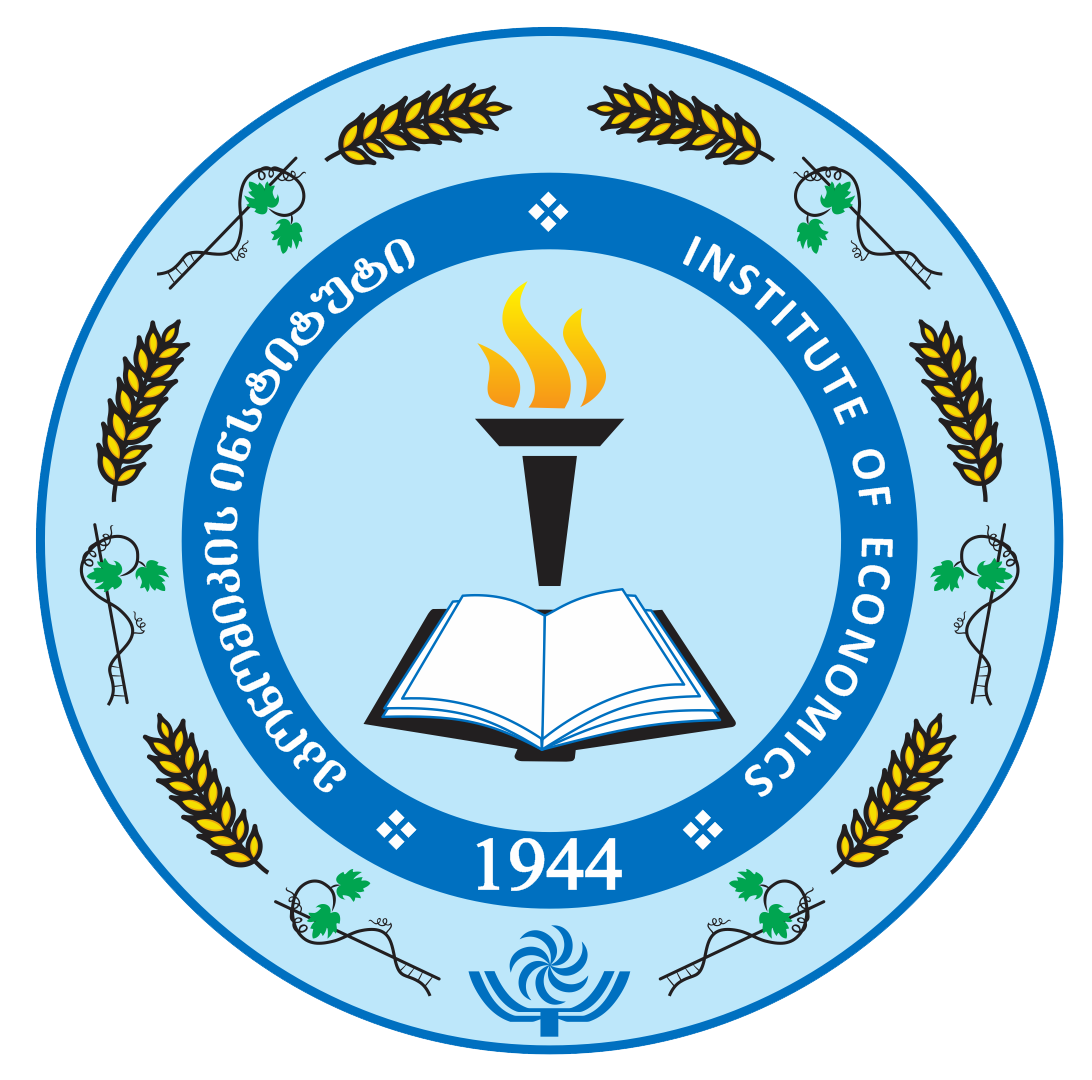
Economic policy that promots the implementation of innovations in Georgian Agriculture, through Industry 4.0
Annotation: The current data and challenges of agriculture in Georgia are analyzed in the article. The article also discusses innovative approaches that allow entrepreneurs to be more productive and competitive during the fourth industrial revolution. The article analyzes the existing programs in Georgia that contribute to the development of agriculture. The current data in Georgia was compared with the average data of the world. Based on these data, a regression model is built that establishes the relationship between resources spent on research and development and agricultural output. Conclusions and recommendations are made based on the research.
Key words: Innovation, Agriculture, Fourth Industrial Revolution, Economic Policy
Introduction
Innovations are the most important factor of human development. It is a driving force of economic growth and prosperity that allows countries and entrepreneurs to create new goods, increase productivity and compete with other business entities in the market. Innovation also creates new industries and jobs, increasing employment and income levels. It is worth noting that countries that invest in innovation (in R&D (Research & Development)) have high rates of economic growth and development, and entrepreneurs who use innovative methods are more profitable, competitive and successful. Technological progress and globalization have greatly contributed to the economy in terms of innovation.
Pursuing the right economic policies is vital to drive innovation in the economy. This can be investing in education, promoting research and development, supporting small entrepreneurs and providing them with the right information. It is also important for countries to have the ability to protect intellectual property, which will make the development of this field more sustainable.
The world population is constantly increasing. The world population has grown at a fairly rapid pace since the 1950s. This was partly due to the fact that the world wars had ended and technological progress had helped to increase the life expectancy of people. In the early 1900s, the average human life expectancy did not exceed 40 years, and today it is about 73 years (Roser, Ortiz-Ospina, & Ritchie, 2019). Based on studies by the United Nations, the world population will increase by more than 2 billion in the next 30 years and will exceed 9.7 billion by 2050. If growth continues at the same pace, the world population will reach about 11 billion by the year 2100 (United Nations - Department of Economic and Social Affairs , 2017).
To make the picture more realistic, let's look at the population growth rates. In 1804, the world's population reached 1 billion, and it took almost 123 years for it to increase by another billion, reaching two billion in 1927. It took 33 years to add another billion people. After that, the growth rate increased significantly, reaching four billion in 1974 (after 14 years), five billion in 1987 (after 13 years), and six billion in 1999 (after 12 years) (Hofstrand, 2014).
Increased population directly means increased demand for all kinds of goods and services. Increased demand forces the economy to produce more output, but one circumstance is important. Because our resources are limited, we must make choices.
The most important product that an economy needs is food. It is like fuel for the engine. Certain factors influence food demand. First of all, it is clear that it is a rapid population growth. Studies related to population growth are quite reliable, therefore the fact that the demand for food will increase in the future is also reliable, which the economy must be ready to meet. Another important factor is the increased incomes of the population, especially in developed countries (The World Bank, 2021). The increased incomes of millions of people increase the demand for food and the consumption of agricultural products. These factors laid the foundation for the fourth industrial revolution in agriculture. Agricultural entrepreneurs are trying to meet the increased demand for agricultural products by using new and innovative approaches, advanced techniques, fertilizers, pesticides and other tools.
Our goal is to determine where Georgia is in terms of agricultural development, because this part of the economy is quite important for the country. Agriculture is a sector that accounts for almost 20% of the employed and more than 8% of the gross domestic product.
Methodology
The article discusses agricultural employment in Georgia, its development in 2010-2022, the impact of agriculture on the economy and its role in the country's gross domestic product. The value of goods and services created by people employed in agriculture and those employed in other fields is compared. In order to draw correct conclusions, those agricultural products with the highest productivity were selected. To determine this, data from 2006-2021 has been processed to better show the dynamics of which product's productivity is growing the most. Most of the statistical data is obtained from the official website of the National Statistical Service of Georgia.
In order to see what is the difference between Georgia and the rest of the world, the data is compared with the general indicator of the world. The official website of the World Bank is used to obtain information on international statistics.
2000-2020 data on world spending on research and development and agriculture have been collected. Subsequently, with these data, the correlation between them is determined and a regression model is built.
Currently, Georgia implements a specific economic policy focusing on agricultural development. In addition, there are a number of local and international funded programs that help entrepreneurs to support entrepreneurial endeavors. The article talks about the innovations and technologies that laid the foundation for the fourth industrial revolution.
Innovations in agriculture - the fourth industrial revolution
Modern agriculture is radically different from the approaches of the past. The growth of the world economy has led to an increase in the incomes and demand of the population. That is why entrepreneurs had to come up with new approaches to increase productivity and become more competitive. The main innovative approaches in agriculture today are:
1) Precision agriculture - management and monitoring of production based on data;
2) Vertical farming - growing plants indoors in steps, under artificial lighting conditions;
3) Robotization of agriculture - means planting, maintenance and harvesting of plants by machines (robot);
4) Agricultural biotechnology - breeding of new varieties by means of biotechnology.
Precision agriculture involves monitoring crops and livestock and collecting data for later analysis. This allows the entrepreneur to increase productivity and reduce environmental impact (Wigmore, 2023). Entrepreneurs collect data in different ways. They use satellite photos to help monitor crop health. In addition, special drones are used for aerial monitoring, thus constantly monitoring the farm and crop growth. Through special sensors, soil moisture is determined and irrigation devices are used only when necessary. With the help of sensors, they remotely determine in which specific area the plant needs fertilizer and pesticides (Rajendra, Ram, & Sudhir, 2020).
Vertical farms are the practice of growing plants in vertically stacked layers. Because it requires less land and water than traditional farming, it can also be used in urban areas. The development of vertical farms is in its early stages, but it has great potential to radically change agriculture (Gerrewey, Boon, & Danny, 2021).
The introduction of robotics in agriculture brings additional benefits to farmers. Studies show that by using robots, it is possible to increase productivity, reduce the cost of hiring human resources, increase safety, reduce damage to the environment, and increase the quality of plants (Vougioukas, 2019). The development of the above-mentioned technologies is often related to each other. The development of sensors contributes to the robotization of agriculture. Sensors provide robots with data that allows them to make the right decisions and complete tasks. For example, a robotic harvester uses a sensor to identify ripe fruit (Fountas, et al., 2020).
In addition to the innovations listed above, it is important to increase the yield of a single plant or animal. For centuries, our ancestors tried to change the productivity of the plant. For example, from 1866 to 1899, US corn yields averaged 26 bushels per acre. Yields from 2016 to 2021 averaged 174 bushels per acre, a sixfold increase since the 1800s (Schnitkey, Swanson, Paulson , Coppess, & Baltz, 2022).
Agricultural biotechnology is the application of scientific tools and techniques to improve plants, animals, and microorganisms for agricultural production. It includes a wide range of technologies such as gene editing, molecular breeding, etc.
Agricultural biotechnology is used to develop new crop varieties and livestock breeds that are more resistant to pests and diseases, produce higher yields, and have improved nutritional value.
Policies and programs promoting the development of agriculture in Georgia
For the development of agriculture and economy, it is the duty of the state agencies to promote the development of existing or new enterprises and the introduction of innovations and technologies in them. Several important projects are being implemented in Georgia in this direction.
In 2013-2019, the state spent 1.5 billion GEL to promote the development of agriculture (Erkomaishvili, 2020).
In case a business operator wants to create a new enterprise, or retool and develop an existing enterprise, he can apply to the Rural Development Agency for financing. In 2022-23, 91 business entities were financed and the total cost of financing amounted to 20 million GEL (Government of Georgia, 2023).
In addition, there is a preferential agro-credit system. Since 2014, the decree has entered into force, the purpose of which is to promote agricultural activities with cheap and accessible funds for individuals and legal entities. All major banks operating in Georgia are included in the program, and the interest on the agro-credits issued by them is subsidized by the state. (Government of Georgia, 2014).
In order to increase the competitiveness of the product, the state offers the subjects involved in the programs of the Rural Development Agency:
- Consulting services and trainings;
- Product branding and packaging;
- Introduction of international food safety management systems and standards;
- Granting the recognition of a business operator producing and/or processing food of animal origin; (Government of Georgia, 2020).
In addition to the above-mentioned projects, the government supports specific branches of agriculture. In the state budget of 2023, 5 million GEL was allocated to promote the sale of non-standard apple crops (Government of Georgia, 2023). In the budget of 2022-23, more than 20 million GEL is also provided for the promotion program of hazelnut production.
The use of innovative and high-tech equipment in production reduces the need for human resources and increases productivity. In addition to the fact that the entrepreneur can receive financing for the purchase of equipment within the framework of the above-mentioned programs, there is also a co-financing program for harvesting agricultural equipment. More than 200 business entities benefited from the mentioned program in 2019-23, and the total cost of co-financing amounted to more than 18 million GEL (Government of Georgia, 2019).
Due to its natural and geographical conditions, natural disasters such as hail, floods, storms and autumn frosts are frequent in Georgia. That is why it is important for the entrepreneur to take into account this risk from the beginning and to insure his own crop. Since the mentioned issue is related to additional finances, the state participates in 70% co-financing from 2020, in the insurance of the crops covered by the program. (Government of Georgia, 2020).
Research Part
The largest share of the employed population in Georgia comes from agriculture (agriculture, hunting and forestry, fishing, fisheries). According to the data of 2017-2020, this figure is more than 20% (National Statistical Service of Georgi, 2023). A high rate of employees in the field is characteristic of developing countries (Turkey 18%, Albania 36%, Armenia 24%), among which Georgia is today. In highly developed countries, this rate is lower (Netherlands 2%, USA 1%, United Kingdom 1%) (The World Bank, 2021). In order to better assess the current situation in Georgia in terms of agricultural development, it is important to see its share in the economy. In 2010, the product created by agriculture amounted to approximately 1.8 billion GEL. In the next seven years, this indicator increased by 28% and in 2017 it amounted to 2.5 billion GEL. In contrast to the data of 2010-2017, the output created by agriculture in 2017-2022 increased by about 60% and exceeded 4.3 billion, which means that the agricultural sector is characterized by an increasing trend in recent years (see Fig. 1).
Figure 1 - Agricultural output in Georgia (million GEL)
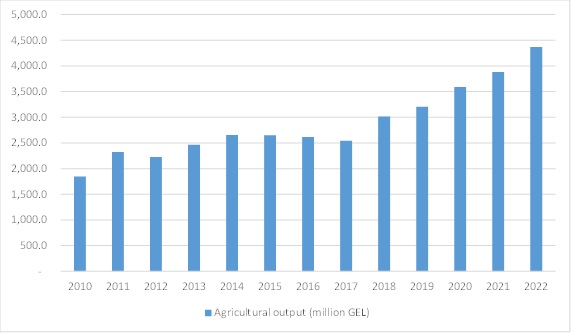
Source: National Statistical Service of Georgia(National Statistical Service of Georgi, 2023)
At the same time, it is important to what extent the country's economy depends on the mentioned field. In 2010, the share of agriculture in the gross domestic product (GDP) was 8.4%. This indicator was almost in the same range until 2022. According to today's data, the share of agriculture in the GDP of 2022 is 6%. The decrease of the mentioned indicator is due to the fact that the GDP of 2010 to 2022 increased more than agriculture (see Fig. 2).
Figure 2 - Share of agriculture in GDP. 2010-2022 years
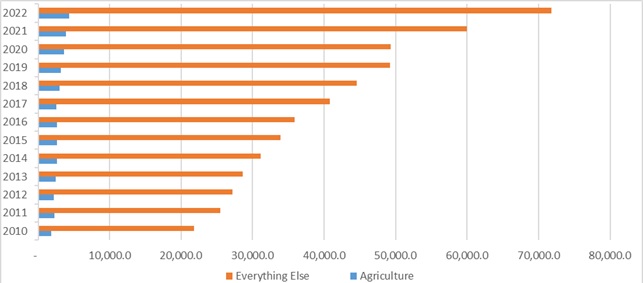
Source: National Statistical Service of Georgia(National Statistical Service of Georgi, 2023)
In the period 2000-2021, the share of agriculture in GDP ranges from 3.3% to 4.4%. In developed countries, this rate is low (USA 1%; United Kingdom 0.7%; France 1.6%), and in developing (Armenia 11.3%; Ukraine 10.6%; Albania 17.7%) and underdeveloped (Burundi 29%; Guinea 26%) countries it is much higher (The World Bank, 2023). Obviously, these data do not mean that agriculture is not developed in developed countries and vice versa in others. In order to see the level of development of agriculture in this or that country, it is important to see how many products are created during the year by the people employed in the field. As mentioned above, in developed countries, quite a small part of employed people comes from agriculture, while in developing and underdeveloped countries this figure is high.
If we consider the example of Georgia, we will see that from 2017 to 2020, the value of goods/services created by people employed in agriculture increased from approximately 8800 GEL to almost 14500 GEL. Obviously the growth is significant, but it is important to consider what is happening in other large employer areas. Figure 3 clearly shows that the value created by an employee in construction during the year is on average 4 times greater than that of agriculture, trade is on average more than 2.5-3 times, and science and technology is more than 5 times (see Figure 3).
Figure 3 - Goods/services created by people employed in different fields in Georgia during one year (expressed in GEL)
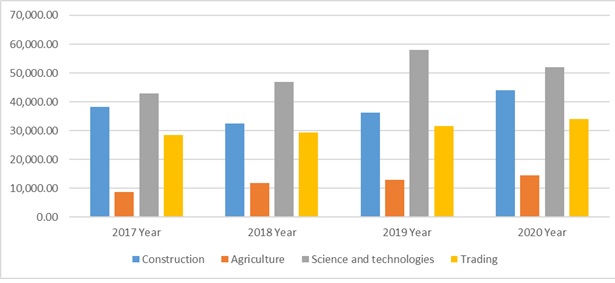
Source: National Statistical Service of Georgia (result obtained using GDP and employment/unemployment statistics(National Statistical Service of Georgi, 2023)
One more indicator can be used to judge the development of agriculture in Georgia. Based on the above information, it is possible to say that during the last 13 years, agriculture in Georgia has developed, but it is important to assess which goods' productivity has increased the most. This will allow you to see which product is more advantageous for Georgia than others. The analysis of the average yield of annual crops shows us that productivity has increased. In the case of some products, the productivity in 2021 has increased by more than 100% compared to 2006: wheat - 125%; Bagcheuli - 133%. We also have an increase in the production of other products, although this indicator does not exceed 100%: barley - 75%; corn - 66%; beans - 40%; sunflower - 16%; potatoes - 93%; Vegetables - 56% (see Fig. 4).
Figure 4 - Productivity of different branches of agriculture in Georgia per hectare (note: the data for potatoes, vegetables and bacheuli are given per 1000 m2)

Source: National Statistical Service of Georgia(National Statistical Service of Georgi, 2023)
In order to see the real picture of Georgia's agricultural development compared to the rest of the world, it is necessary to compare the above results with the average results in the world.
- According to the data of 2006, the production of wheat in the world was 140% higher than in Georgia. This number has decreased to 29.5% by 2021.
- According to 2006 data, barley production in the world was 112% higher than in Georgia. This number has decreased to 37.6% by 2021.
- According to the data of 2006, the production of corn in the world was 165% higher than in Georgia. This number has decreased to 96% by 2021.
- According to the data of 2006, the production of beans in the world was 50% higher than in Georgia. This number has decreased to 10% by 2021.
- According to 2006 data, sunflower productivity in the world was 118% higher than in Georgia. This number has increased to 180% by 2021.
- According to the data of 2006, the production of beans in the world was 133% higher than in Georgia. This number has decreased to 46% by 2021. (see Fig. 5)
Figure 5 - Productivity of different branches of agriculture in the world per hectare (note: potato data
is given per 1000 m2)
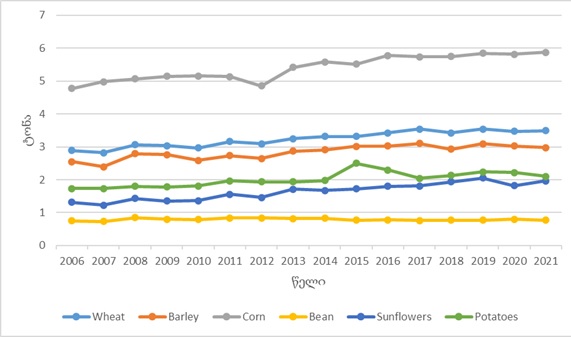
Source: Our World in Data (Our World in Data, 2023 )
In the case of perennial crops, the growth is fixed in the case of fruits (except grapes and citrus) (11% growth from 2014 to 2021) and grapes (57% growth from 2014 to 2021). In the case of citrus, the decrease is 12% (see Table 1).
Table 1 - Production of perennial agricultural crops in Georgia (thousand tons)
|
Prosduct |
Year |
2014 |
2015 |
2016 |
2017 |
2018 |
2019 |
2020 |
2021 |
|
Fruits (except grapes and citrus) |
210 |
144,3 |
186,4 |
114,1 |
188,2 |
144,4 |
228,6 |
233,3 |
|
|
Grapes
|
172,6 |
214,5 |
159,2 |
180,8 |
259,9 |
293,8 |
316,9 |
271,6 |
|
|
Citrus
|
69,8 |
77,6 |
65,5 |
58,2 |
66,3 |
64 |
56,8 |
61,6 |
|
Source: National Statistical Service of Georgia (National Statistical Service of Georgi, 2023)
The amount spent on research and development (Research and development (R&D)) is directly related to the introduction of innovations. With the growth of the economy, countries increase the accumulation of funds in this direction. In order to see the effect of R&D spending on agriculture, it is necessary to examine the correlation between Mt. First of all, data was collected regarding the funds spent on R&D worldwide (The World Bank, 2023). In addition, data were collected regarding the total output of the agricultural sector in the world (Our World In Data, 2023).
Table N2 - R&D expenditure and agricultural output (world)
|
Year |
2000 |
2001 |
2002 |
2003 |
2004 |
2005 |
2006 |
2007 |
2008 |
2009 |
2010 |
|
Share of R&D in world GDP (%) |
2.05 |
2.07 |
2.04 |
2.03 |
1.98 |
1.96 |
1.97 |
1.94 |
1.99 |
2.03 |
2.01 |
|
Agricultural output trillion dollars (world) |
1.31 |
1.28 |
1.31 |
1.52 |
1.78 |
1.89 |
2.74 |
2.52 |
2.98 |
2.75 |
3.19 |
|
Year |
2011 |
2012 |
2013 |
2014 |
2015 |
2016 |
2017 |
2018 |
2019 |
2020 |
|
Share of R&D in world GDP (%) |
2 |
2.03 |
1.99 |
2.07 |
2.1 |
2.14 |
2.13 |
2.2 |
2.33 |
2.63 |
|
Agricultural output trillion dollars (world) |
3.89 |
3.92 |
4.2 |
3.5 |
3.65 |
3.62 |
3.74 |
4.15 |
4.23 |
4.45 |
According to the data in Table N2, the correlation between the two data, the share of R&D in world GDP (%) and agricultural output is calculated. The correlation is 0.493944026, which means that there is a positive correlation between these two data, although the correlation is not very high. Obviously, agricultural production, in addition to modern technologies and innovations, is affected by such factors as food demand, weather changes, etc.
A regression model is built based on the same data:

Formula N1 F(x) = 3,464x - 4,2249 R2 = 0,244
The regression model, F(x) = 3.464x - 4.2249, relates the two data above. The model's R2 value of 0.244 indicates that about 24.4% of the variation in R&D expenditure can be explained by changes in agricultural output. Although this model offers a moderate amount of explanation, it is important to consider other factors to determine the relationship between these variables, as mentioned above.
Conclusions and recommendations:
As a result of the research, the following circumstances were identified
- There is a positive correlation between funds spent on research and development and agricultural output, which indicates the importance of funds spent on research and development;
- Georgian agriculture is characterized by a growth rate from 2006 to 2021, both in terms of individual product and total product value. The reason for this, along with other external factors, is the programs that are implemented in terms of agricultural development;
- The value of products and services created by employees in Georgian agriculture is much lower than that of employees in other fields. Moreover, compared to developed countries, the percentage of people employed in the field of agriculture in Georgia is quite high;
- Compared to the world's average data, certain branches of Georgian agriculture are characterized by less productivity, although the decrease of the mentioned difference is visible when analyzing the data of 2006-2021.
As a recommendation, it can be said that:
- Along with the existing programs, it is important to develop new programs that will contribute to the innovative development of agriculture. This will ultimately lead to an increase in productivity and the country's competitiveness in the market;
- It is necessary to inform the entrepreneurs employed in agriculture about the innovative approaches and methods that are actively used in agriculture in the world today;
- Emphasis on those agricultural products, which are characterized by high productivity and growth rates compared to other products.
